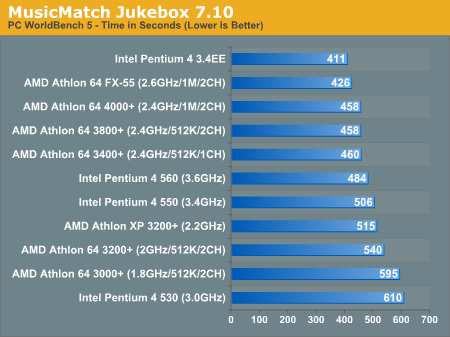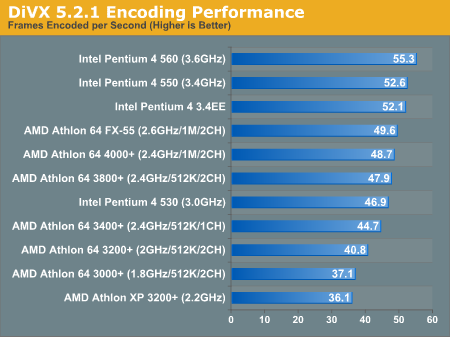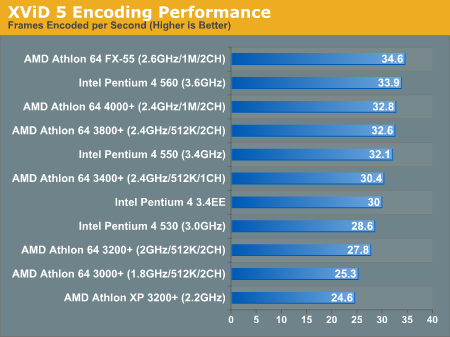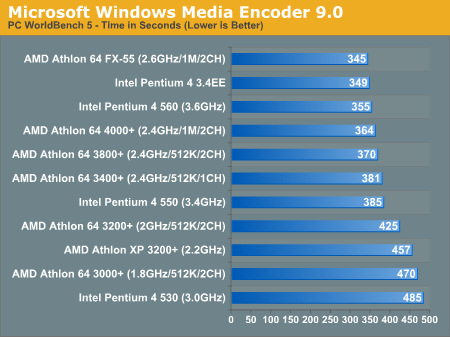AMD Athlon 64 4000+ & FX-55: A Thorough Investigation
by Anand Lal Shimpi on October 19, 2004 1:04 AM EST- Posted in
- CPUs
Audio/Video Encoding
MusicMatch Jukebox 7.10
An audio encoding favorite of Intel's from past Pentium 4 launches, MusicMatch Jukebox shows the Pentium 4 3.4EE taking a small 3.5% lead over the FX-55. Despite Intel's first place victory here, AMD takes the next four spots. Once again we see that there's no performance difference between the 3800+ and the 4000+, but looking at the lack of performance improvement from the 3400+ to 3800+ jump we see why: MP3 encoding is quite CPU bound, larger caches and more memory bandwidth don't matter much, it's all about clock speed here. Thus it's not too surprising to see the Athlon XP 3200+ outperform the Athlon 64 3200+ thanks to a shorter pipeline and higher clock speed. AMD's on-die memory controller does little for it here, neither does Intel's Prescott core though.

DiVX 5.2.1 with AutoGK
Armed with the latest version of DiVX (5.2.1) and the AutoGK front end for Gordian Knot, we took all of the processors to task at encoding a chapter out of Pirates of the Caribbean. We set AutoGK to give us 75% quality of the original DVD rip and did not encode audio.
Despite AMD becoming more competitive in DiVX encoding performance, Intel once again pulls head, with the Pentium 4 560 pulling away as the fastest DiVX encoder out of the bunch. Even the more reasonably priced Pentium 4 550 is able to outperfom the Athlon 64 FX-55, and it's not until we drop down to the 3GHz mark that AMD is able to win any ground.
Heavy optimizations for NetBurst give Intel the DiVX encoding performance crown.

XViD with AutoGK
Another very popular codec is the XViD codec, and thus we measured encoding performance using it instead of DiVX for this next test. The rest of the variables remained the same as the DiVX test.
Using XViD the performance situation is flipped on us, this time instead of Intel being on top we're left with the Athlon 64 FX-55 - although it's worth mentioning that the Pentium 4 560 is close behind. To no surprise there's a noticeable increase in performance from the single channel 3400+ to the dual channel Socket-939 3800+ of 7% to be exact. Once again we see no performance boost for the additional cache of the Athlon 64 4000+.

Windows Media Encoder 9
To finish up our look at Video Encoding performance we've got two tests both involving Windows Media Encoder 9. The first test is WorldBench 5's WMV9 encoding test.
Here we see that the Athlon 64 FX-55 and Pentium 4 3.4EE are basically tied for the first place position, followed by the Pentium 4 560 and all of the 2.4GHz Athlon 64s. Here the Athlon 64 3400+ appears to do about as well as the Pentium 4 550, which is either saying a lot for the Pentium 4 550 or very little for the 3400+.

But once we crank up the requirements a bit and start doing some HD quality
encoding under WMV9 the situation changes dramatically.
Here the Pentium 4 560 takes the lead, followed by the Pentium 4 3.4EE
and then the FX-55. The performance difference between the Pentium 4 560
and
the FX-55 is just under 9%, enough to give Intel the clear win here. Only
the Pentium
4 530 is really able to be challenged by the AMD chips.

Closing up our video encoding tests, while AMD does win some, with appropriate optimizations in place Intel seems to be the right candidate here.










89 Comments
View All Comments
Live - Tuesday, October 19, 2004 - link
Splendid reading! This site is doing a great job right now. I really would love more of these very informative articles that help you so at seeing the big picture.A really helpful article.
Disorganise - Tuesday, October 19, 2004 - link
I’m a bit disappointed by you inconsistency…The comparison with Intel over who wins….slightly inconsistent but no biggie.
What really is bad though, is the penultimate page – is socket 939 worth it?
I agree it is but…..
You’ve taking an identical chip and found it about 5% quicker than on socket 754. OK, no problem. But AMD have wacked a whopping 12% increase in rating, to 3800+ from 3400+. It doesn’t gel, the numbers don’t work.
The 3800+ is also more expensive than the 3400+ to the tune of about 250% here in Australia and about 220% over there in the U.S. a 5% increase in performance does not warrant a doubling in price.
Dave
at80eighty - Tuesday, October 19, 2004 - link
way to go Anand...excellently comprehensive article.../waiting for those HDD articles you promised : p
SLIM - Tuesday, October 19, 2004 - link
Going along with what #6 said:Athlon 64 4000+ - 2.4GHz - 1MB - 128-bit
Athlon 64 3800+ - 2.4GHz - 512KB - 128-bit
Athlon 64 3400+ - 2.4GHz - 1MB - 64-bit <---should be a socket 754 3700+ right?
Athlon 64 3400+ - 2.4GHz - 512KB - 64-bit
Athlon 64 FX-53 - 2.4GHz - 1MB - 128-bit
SLIM
ViRGE - Tuesday, October 19, 2004 - link
#12, even GPUs aren't going anywhere fast. There's still a shortage of something or other needed to make the Ultra/PE parts, and there isn't a planned refresh for 2004. ATI/Nvidia have another speed grade of RAM to jump to(1.6ghz GDDR3), and can die-shrink down to 90nm once TSMC gets there, but they're so close to CPUs right now, they're destined to hit the same wall too.Anand, someone has been a busy beaver.;-) That was a long, but well thought out and informative article; you've basically written the definitive CPU article for now until the multicores come out.
Tides - Tuesday, October 19, 2004 - link
Ah I read the conclusion wrong.Tides - Tuesday, October 19, 2004 - link
why is this site putting down an amd performance gain and making excuses for intel at the same time.Doormat - Tuesday, October 19, 2004 - link
Its a shame the processor wars are coming to an end. I see dual core as neat, but a dud performance wise. It'll be another year or two before the GPU wars start to die out... hmmm..-CPU performance levels off
-HD capacity levels off
The only interesting stuff going on is GPU stuff.
dvinnen - Tuesday, October 19, 2004 - link
Best artical from Anandtech I've read in a long time. Good job Anand.skiboysteve - Tuesday, October 19, 2004 - link
wait nevermind, you put your comments ABOVE the graphs. threw me off cause this isnt what you usualy do...